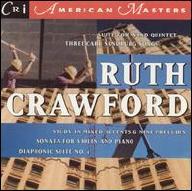She was born in an Eastern Ohio coal-mining town, where her father was the Methodist minister. Her mother taught her piano. When she was ten the church transferred the family to Jacksonville, Florida. Rev. Crawford died two years later. To help bring income, she worked as a piano teacher in the public schools when she was still in junior high and high school.
She attended the American Conservatory in Chicago, supporting herself as movie theater usherette and hat-check girl. She studied piano, and took composition from John Palmer and Adolf Weidig. On graduation she began teaching at the Conservatory and at nearby Elmhurst College of Music.
One of her students was the daughter of the famous poet Carl Sandburg. She assisted him in compiling his anthology -The American Songbook. Her music began to appear in the "New Music Editions."
She studied with Djana Lavoi-Herz, winning her Masters in 1929. She acted on Lavoie-Herz's suggestion that she go east, and went to the MacDowell Colony in New Hampshire.
Her next teacher was Charles Seeger (1886-1979) in New York. She became the first woman to win a Guggenheim Fellowship for study in Europe. Meanwhile, her music was becoming more chromatic and dissonant until she approached the forefront of the American avant garde of the day.
After she returned to the United States she married Seeger, becoming the step-mother of Pete Seeger and soon the mother of Michael and Peggy Seeger, all of whom later became noted folk-singers, most likely through Ruth's influence. Her husband introduced her to the music and theoretical writing of Arnold Schoenberg, as a result of which she became one of the first Americans to write a twelve-tone piece, her 1931 String Quartet. In 1933 her Three Songs was selected as the official representative work for the USA at the International Society for Contemporary Music Festival.
In 1935 the Seegers moved to the Washington, D.C. area where Charles was assistant director of music in the WPA and musical director of the Pan American Union. Ruth joined John and Alan Lomax in working for the Library of Congress, on its collection of American folksong. Together they published the great volume -Our Singing Country. She also published four folksong collections for children. She also taught music in nursery schools
She had no time for composition, which she abandoned in the 1930s. She only took up composition again in the early 1950s, when the children were grown and she was able to cut back on the other activities. Any further development of her career was prevented by her early death in 1953.
By the end of the 20th Century her music was only in the early stages of being "discovered." The music is imaginative, personal, and often strongly dissonant, with the impression of a bold spirit on the part of its author. She applied serial procedures to other aspects of composition than the notes, even anticipating Webern to some extent, and was very fond of glissando effects in instrumental and vocal music. ~ Joseph Stevenson, Rovi












